





Today we will take a closer look at two rather similar plants that are often mistaken for one another, at least in their names. Indeed, many people refer to Brugmansias as 'datura' or 'tree datura' plants. Although this is not the worst mistake in the world, mixing them up can make botanists and dedicated growers cringe
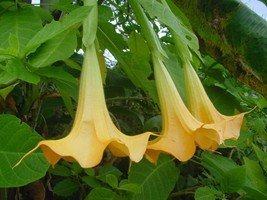 These two plants share some common traits: they both bear hairy leaves that exude a fetid smell when crushed or simply brushed, they have perfumed, funnel-shaped flowers and a reputation for being sorcerer's plants! In fact, although Daturas were known by Europeans (and used mostly by witches and poisoners) it was not until the discovery of the New World that Brugmansias appeared in the documented floras and later in gardens of the Old World. Initially Brugmansias were grouped with Daturas by the famous botanist Carl Linné, who documented them in 1753 from a drawing and not from live plant material. In 1805, the South African taxonomist Christian Hendrik Persoon created a separate genus for Brugmansia, but it was not until 1973 that Tom E. Lockwood created a final division between the two genera with his doctoral thesis at Harvard University.
These two plants share some common traits: they both bear hairy leaves that exude a fetid smell when crushed or simply brushed, they have perfumed, funnel-shaped flowers and a reputation for being sorcerer's plants! In fact, although Daturas were known by Europeans (and used mostly by witches and poisoners) it was not until the discovery of the New World that Brugmansias appeared in the documented floras and later in gardens of the Old World. Initially Brugmansias were grouped with Daturas by the famous botanist Carl Linné, who documented them in 1753 from a drawing and not from live plant material. In 1805, the South African taxonomist Christian Hendrik Persoon created a separate genus for Brugmansia, but it was not until 1973 that Tom E. Lockwood created a final division between the two genera with his doctoral thesis at Harvard University.
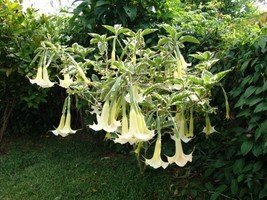 What distinguishes Daturas from Brugmansias is a set of criteria that are obvious even to a neophyte. The stem of the former is herbaceous and does not grow more than 1 1/2 half meters (4 feet) high while the latter has a woody stem and can reach 8 meters (24 feet) high. The datura is usually an annual or a biennial plant while Brugmansias will live for many years. Daturas display erect flowers while their big cousins have pendulous ones; fruits of the former are rounded spiny capsules that look somewhat like a chestnut while the latter is always void of spines and has an elongated shape. A final way to differentiate between the two is in their seeds: Brugmansia seeds are surrounded by a corky envelope. This envelope is lacking around Datura seeds which have caruncles (appendages sticking to the seeds, full of greases and proteins.) You will also find Brugmansias are often grown in gardens or as potted plants in cooler areas, but Daturas are seldom cultivated and usually found in wastelands, fallows and abandoned places. An exception would be the Datura metel cultivars, some having purple flowers, offered as seed and plants in nurseries.
What distinguishes Daturas from Brugmansias is a set of criteria that are obvious even to a neophyte. The stem of the former is herbaceous and does not grow more than 1 1/2 half meters (4 feet) high while the latter has a woody stem and can reach 8 meters (24 feet) high. The datura is usually an annual or a biennial plant while Brugmansias will live for many years. Daturas display erect flowers while their big cousins have pendulous ones; fruits of the former are rounded spiny capsules that look somewhat like a chestnut while the latter is always void of spines and has an elongated shape. A final way to differentiate between the two is in their seeds: Brugmansia seeds are surrounded by a corky envelope. This envelope is lacking around Datura seeds which have caruncles (appendages sticking to the seeds, full of greases and proteins.) You will also find Brugmansias are often grown in gardens or as potted plants in cooler areas, but Daturas are seldom cultivated and usually found in wastelands, fallows and abandoned places. An exception would be the Datura metel cultivars, some having purple flowers, offered as seed and plants in nurseries.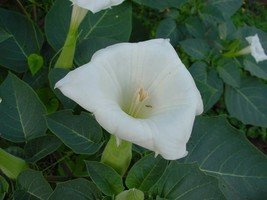
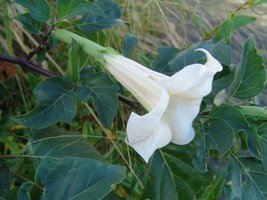 There are several species of Brugmansias (9 to 14 depending on the author) which differ by the size of the flowers, their colour, the shape of the corolla, the opening of the chalice, whether the stamens are united or not, and the shape of the fruits. The most common is Brugmansia arborea which has small (12 to 17cm long) white or cream flowers. B. aurea produces yellow or golden flowers, sometimes white or pink and B. sanguinea has tubular red flowers and is not too often grown. B. suaveolens is probably the most grown and displays white, yellow or pink flowers which have a strong perfume at nightfall. B. versicolor is the record-holder for flower size, they can reach 30 to 50 cm (1 to 1 1/2 feet) long, they start white and then gradually turn apricot, pink or white. There are an ever-increasing number of hybrids, including spontaneous hybrids from the wild as well as those created by growers and enthusiasts. The hybrids offer a vast array of shapes and colours of the flowers, some with double or even triple corolla and there are also a few cultivars with variegated foliage such as ‘Maya' or ‘Miner's Claim'.
There are several species of Brugmansias (9 to 14 depending on the author) which differ by the size of the flowers, their colour, the shape of the corolla, the opening of the chalice, whether the stamens are united or not, and the shape of the fruits. The most common is Brugmansia arborea which has small (12 to 17cm long) white or cream flowers. B. aurea produces yellow or golden flowers, sometimes white or pink and B. sanguinea has tubular red flowers and is not too often grown. B. suaveolens is probably the most grown and displays white, yellow or pink flowers which have a strong perfume at nightfall. B. versicolor is the record-holder for flower size, they can reach 30 to 50 cm (1 to 1 1/2 feet) long, they start white and then gradually turn apricot, pink or white. There are an ever-increasing number of hybrids, including spontaneous hybrids from the wild as well as those created by growers and enthusiasts. The hybrids offer a vast array of shapes and colours of the flowers, some with double or even triple corolla and there are also a few cultivars with variegated foliage such as ‘Maya' or ‘Miner's Claim'.
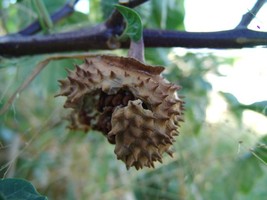 Brugmansias are rather easy to grow, if you remember that they are quite greedy in term of water and nutrients. They enjoy a soil able to retain both, but not to the point the plant becomes waterlogged, as that will cause the roots to rot. The plant is responsive to manure or fertilizer which promotes masses of flowers. It is a quite strong plant once established and can withstand severe pruning after flowering to keep it to a manageable size, especially if it has to be over-wintered indoors; it can also be pruned to various shapes. Pruning will also allow easy propagation. Shoots selected from parts which previously flowered will produce flowers earlier than cuttings taken from lower parts of the tree. Herbaceous or woody cuttings will both do fine, large ones are fine (about 30 cm or 1 foot long) but you can also make larger ones, up to 1 m (3 feet) long, placed either in a pot or directly in a lightly shaded spot in the garden. Seeds are not very reliable as the plants easily cross-pollinate and the resulting plants might differ greatly from the mother plant. Conversely, Daturas are most often propagated by seeds.
Brugmansias are rather easy to grow, if you remember that they are quite greedy in term of water and nutrients. They enjoy a soil able to retain both, but not to the point the plant becomes waterlogged, as that will cause the roots to rot. The plant is responsive to manure or fertilizer which promotes masses of flowers. It is a quite strong plant once established and can withstand severe pruning after flowering to keep it to a manageable size, especially if it has to be over-wintered indoors; it can also be pruned to various shapes. Pruning will also allow easy propagation. Shoots selected from parts which previously flowered will produce flowers earlier than cuttings taken from lower parts of the tree. Herbaceous or woody cuttings will both do fine, large ones are fine (about 30 cm or 1 foot long) but you can also make larger ones, up to 1 m (3 feet) long, placed either in a pot or directly in a lightly shaded spot in the garden. Seeds are not very reliable as the plants easily cross-pollinate and the resulting plants might differ greatly from the mother plant. Conversely, Daturas are most often propagated by seeds.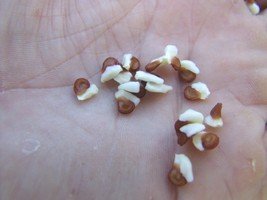
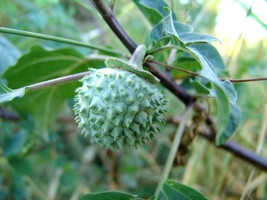 On Reunion Island, Brugmansias are a common sight in gardens though they thrive better in uplands as they do not enjoy the dryness of lowlands where flowers will soon wilt. Daturas are found in the wild and limited to three species on the island (depending on the author, there are 9 to 11 species worldwide); D. inoxia, D. metel and D. stramonium which all are quite similar and often dismissed as weeds. They also have a rather bad reputation as they are frequently associated with sorcerers and evil people; hence the colloquial names such as ‘devil's trumpet', ‘zombie cucumber', ‘sorcerer's weed'. Their names also refer to the fact that both Daturas and Brugmansias, like many other species of the Solanaceae family, contain alkaloids which have toxic properties for body and mind. Scopolamine, hyoscyamine, atropine are a few of those compounds which have been put to use for ages either to poison criminals, put victims to sleep, or--according to legend--make obedient again inconstant husbands and allow witches to fly to their occupations on a broom. (The flying broom legend very likely came from the fact that scopolamine induces hallucinations and perception troubles, causing people to think they are flying in the air.) Brugmansia have also been used by shamans of Latin America for ages to reach trances and perform rituals. Of course, like many toxic plants, they have medical uses and Datura leaves are part of the mix found in some anti-asthma cigarettes, but dosage is an extremely difficult thing to master so do not under any circumstances attempt to self-treat your asthma by smoking the garden leaves. You may very well end in hospital as the alkaloid levels may vary from one plant to another, from one part of the same plant to another and even according to the season and time of the day, far too many variables for the common gardener to measure.
On Reunion Island, Brugmansias are a common sight in gardens though they thrive better in uplands as they do not enjoy the dryness of lowlands where flowers will soon wilt. Daturas are found in the wild and limited to three species on the island (depending on the author, there are 9 to 11 species worldwide); D. inoxia, D. metel and D. stramonium which all are quite similar and often dismissed as weeds. They also have a rather bad reputation as they are frequently associated with sorcerers and evil people; hence the colloquial names such as ‘devil's trumpet', ‘zombie cucumber', ‘sorcerer's weed'. Their names also refer to the fact that both Daturas and Brugmansias, like many other species of the Solanaceae family, contain alkaloids which have toxic properties for body and mind. Scopolamine, hyoscyamine, atropine are a few of those compounds which have been put to use for ages either to poison criminals, put victims to sleep, or--according to legend--make obedient again inconstant husbands and allow witches to fly to their occupations on a broom. (The flying broom legend very likely came from the fact that scopolamine induces hallucinations and perception troubles, causing people to think they are flying in the air.) Brugmansia have also been used by shamans of Latin America for ages to reach trances and perform rituals. Of course, like many toxic plants, they have medical uses and Datura leaves are part of the mix found in some anti-asthma cigarettes, but dosage is an extremely difficult thing to master so do not under any circumstances attempt to self-treat your asthma by smoking the garden leaves. You may very well end in hospital as the alkaloid levels may vary from one plant to another, from one part of the same plant to another and even according to the season and time of the day, far too many variables for the common gardener to measure.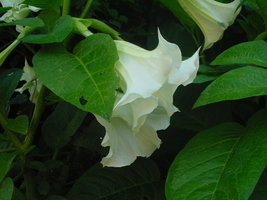
In conclusion, we can say without a doubt that the Brugmansia is a beautiful plant which may become fearsome if you do not stick to just growing it. If your neighbour has wonderful Brugmansias in his garden, no problem; but if he also grows Datura do not get into arguments with him, you never know what he might do...
Copyright © www.100flowers.win Botanic Garden All Rights Reserved